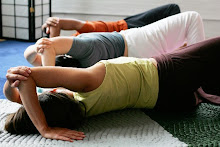 Image via Wikipedia
Image via Wikipedia
The spirit in which words are chosen matters. It all depends on the topic and your point of view to determine whether the search for finer distinctions is an engaging exploration, or arbitrary nit-picking and hair-splitting.
So, I began to wonder about the distinctions between "problem solving" and "solution finding." Point of view, intention, and habitual ways of perceiving can make a big difference in whether, or how, you change your situation to the better. It's a similar stance to your personal view of "is the glass half empty, or half full?"
People come to me with problems. They have pain, or difficulty, or impaired function. They have a desire for things to be different, and better, for them. In part, the Feldenkrais Method shifts the attention away from the problem or deficit, and toward solutions. Not just "a solution," or "the solution," but to come up with multiple solutions. The situation improves, not by ignoring or denying the difficulty, but by working (or playing) with it to transform it.
Each Feldenkrais lesson is an experiment in problem-solving/solution-finding. Each lesson begins with a small, gentle, safe, comfortable movement of some part of your body. Gradually, you realize that that part of you is connected to some other part of you, and it moves, too. The task is to find the simplest, most comfortable, most efficient and economical ways to allow the movements to change, and grow. You don't have to figure it out on your own. Your Feldenkrais teacher guides and facilitates the process. You find solutions that work for you. Or, you begin to learn a process for finding solutions in the future. It's all good.
I find that focusing exclusively on the problem side of the equation makes the problem grow, and even multiply. People get stuck with a problem because they can't find a way to change it. I love the exploratory action of the Feldenkrais Method, because it accesses each person's curiosity and creativity. Some folks have not accessed their curiosity and creativity since they were small children.
The catalyst for the creative process is the question, "What else?" What else could you do? How else could you do it? For example: whatever you are doing, try doing it:
- slower
- faster
- smaller
- larger
- smoother
- "jagged-er"
- shorter duration
- longer duration
- looser
- tighter
- in reverse
- sitting, standing, walking, staying, lying down: on front, on back, on side (change your position)
All of this pre-supposes that you know what you're doing in the first place, before you start changing it. As Moshe Feldenkrais said, "If you don't know what you're doing, then you can't do what you want." His work incorporates a hardy optimisim that things can always improve. The Feldenkrais Method sees your glass as half full, and endlessly refilling. "Another round" is always on the way.

![Reblog this post [with Zemanta]](http://img.zemanta.com/reblog_e.png?x-id=c68b1983-ef34-487f-b5a6-2ac99cfeccaf)


4 comments:
I love this! I am passing it along and maybe putting part of it up on my wall to help with moments of writer's block!
Awesome, can I post this on my blog? (In your name of course)
Glad to discover your blog, NatureWriter!
Be my guest, Lavinia! Please send me the URL when you re-blog it.
Post a Comment